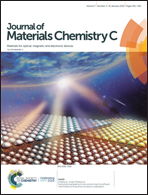Nonlinear optical response of endohedral all-metal electride cages 2e−Mg2+(M@E12)2−Ca2+ (M = Ni, Pd, and Pt; E = Ge, Sn, and Pb)
Abstract
To extend the interesting new concept of the all-metal electride, a series of endohedral all-metal electride cages 2e−Mg2+(M@E12)2−Ca2+ (E = Ge, Sn, and Pb; M = Ni, Pd, and Pt) has been designed and investigated theoretically using the exchange–correlation functional CAM-B3LYP. In these electride cage molecules with excess electrons, interesting pull–push electron transfer relay occurs. The metal cage M@E12 first pulls valence electrons from Ca atom forming a polyanion (M@E12)2−, and then the formed polyanion pushes valence electrons of Mg atom out of its valence shell generating the isolated excess electrons that characterize this species as all-metal electrides. These endohedral all-metal electride cages display a large electronic first hyperpolarizability (βe0) and so they could have a potential application as a new kind of second-order nonlinear optical (NLO) material. We have explored the structure–property relationships, which are significant. It is shown that, for a given central atom, the all-metal electrides with a Sn-cage correspond to the largest βe0, whereas, for a given metal cage, the all-metal electrides with Ni as the central atom correspond to the largest βe0. Owing to the two effects, the endohedral all-metal electride cage 2e−Mg2+(Ni@Sn12)2−Ca2+ exhibits the largest βe0 value (16 893 a.u.). The same conclusions are also valid for the frequency-dependent βe(−2ω; ω, ω) and βe(−ω; ω, 0). Moreover, we have also explored the role of the vibrational contribution in the largest components (in x-axis) of static β for endohedral all-metal electride cages. The vibrational contributions are significant for new all-metal electride NLO properties and therefore should be considered in the design of new NLO all-metal electrides.



 Please wait while we load your content...
Please wait while we load your content...